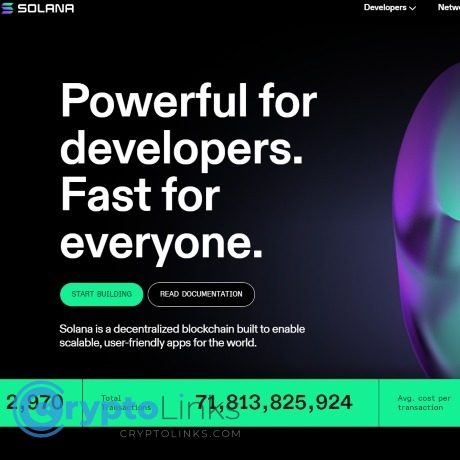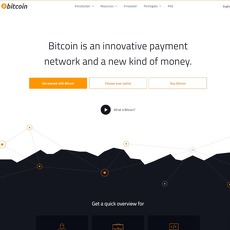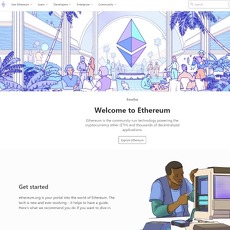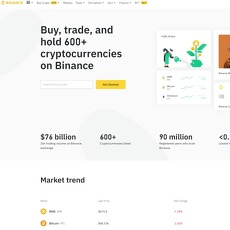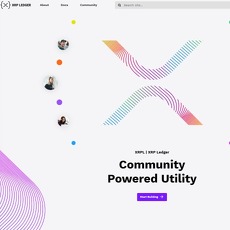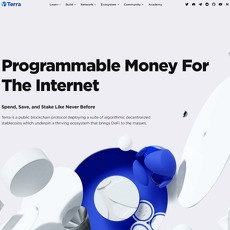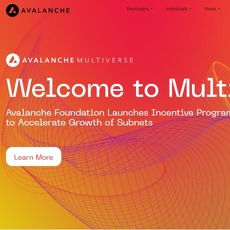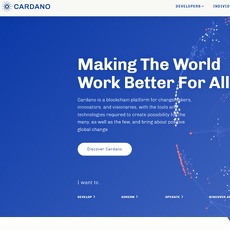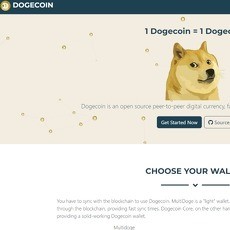Solana (SOL) Review
Solana (SOL)
solana.com
Solana Website Review
- Solana is a blockchain platform interconnected with the blockchain.
- It is an open-source project originally founded in 2017.
- The Solana protocol is specifically developed as a means of facilitating decentralized application (dApp) creation.
- It aims to improve scalability through the introduction of the Proof-of-History (PoH) consensus, which is combined with the underlying Proof-of-Stake (PoS) consensus of the blockchain.
With the rise in interest surrounding cryptocurrencies as a whole throughout the past few years, there have been numerous new blockchain networks that aim to be competitors to the ones that have a high market capitalization.
Solana was launched in 2017 as the main competitor to blockchain networks such as Ethereum. It is a highly-functional, open-source project that banks on blockchain technology's permissionless nature as a means of providing decentralized finance (DeFi) solutions.
Today, we are going to go over just about everything that you need to know surrounding the Solana network as we take a look over its website, history, and functionality, and go over some of the pros, as well as some of the cons surrounding the project. Let's dive in.
Solana Website
When you enter the Solana website for the very first time, you are introduced to an amazing animation that consistently loops in the background, showcasing an infinite loop. On the top navigation bar, you have the official SOLANA logo on the right side of the screen, written in all caps. On the left side of the screen, however, you have multiple other categories and websites that you can visit. We will be starting from those.
First, there is the Developers page, which takes you to multiple other sub-pages.
Here, you have resources, such as developer resources, NFTs, DeFi, Gaming, Payments, and DAOs.
Then there's the learning category, which takes you to multiple pages, including the Solana Cookbook, SolDev, Solana Docs, and Metaplex Docs.
Then there are the guides and tutorials, out of which the highlighted ones are:
- Figment Learn
- Questbook x Superteam
- Intro to Building Solana Programs
- Intro To Anchor Framework
- A Guide to Full Stack Development on Solana
- Intro to Solana Blockchain Concepts
Aside from these three categories, you also have careers where you can see all of the available positions on the Solana project.
Next to all of this, you will be able to easily find the Network category, which is also split across four sub-categories, including:
- Inspect - this includes Solscan, Explorer, Solanabeach, and Stake Distribution.
- Status - this includes network status and email alerts.
- Interact - this includes environment and RPC providers.
Then there's the Validator page, which will give you the data that showcases how many validators are running the network at the time of your arrival.
Then there is the community section, which is split across four categories in total.
- The first is the community tab, which has home, events, breakpoint, and branding.
- Then there’s the content tab, which has news, podcast, YouTube, and the newsletter.
- Then there is the socials category, which gives you links to the Twitter page, the Discord page, the Reddit page, and the Telegram page.
- Last, there’s the collective page, which will give you the ability to join the collective.
The Solana Collective is a program that helps Solana supporters contribute to the overall ecosystem and work with core teams. What this essentially means is that anyone can help out and gain numerous benefits.
On the far right of the screen, there is the Ecosystem page.
This will take you to another page, where you can discover the hottest projects that are developed on Solana.
This is split across multiple categories, such as the trending projects of the month, the top DeFi projects, the top lending protocols, and the top NFT marketplaces, as well as the top Web3 apps. You can also sort the Solana-based dApps based on popularity or by the latest projects.
With all of this in mind, we can move on towards looking at the main page.
This page is far from minimal when it comes to its overall design, as it has numerous UI elements that are fully animated.
On the top side of the page, you have the slogan “Powerful for developers. Fast for everyone.”, and underneath it, there are two buttons, including the “Start Building” button, as well as the “Read Documentation” button. Furthermore, the page carries on by telling you that Solana is a decentralized blockchain that is specifically built as a means of enabling scalable and user-friendly apps for the world.
Underneath it, you have a live feed of numerous stats surrounding the Solana blockchain network, including:
- Transactions Per Second (TPS)
- Total Transactions
- Average cost per Transaction
- Validator Nodes
These numbers are ever-changing, so they will differ depending on the point in time when you decide to visit the project’s page.
Right under that, you have another invitation to join the fastest-growing ecosystem, as well as an explanation of what Solana is.
Then there's a video dubbed "Say Hello," which will let you learn more about Solana.
As you scroll further down the page, you are presented with two more benefits when it comes to the Solana blockchain.
- Low cost, forever - here, the blockchain network claims that Solana's scalability ensures transactions remain less than $0.01 for both developers and users.
- Fast, forever - here, the website claims that Solana is all about speed, with 400 millisecond block times. As hardware gets faster, the network becomes faster as a direct result.
Near the bottom of the page, you can gain access to the Solana Community, where you can follow along, chat on Discord, and read up on everything that the development team is doing.
Then, you are also invited to become a validator, which means that you can help in securing the network through running a decentralized infrastructure and learn about operating a validator node.
Then you can gain access to the developer resources, where you can get access to a get started guide, videos, tutorials, SDKs, reference implementations, and more.
With all of this in mind, we will now be moving on toward the history of Solana, as well as its overall functionality, starter guide, videos, tutorials, SDKs, reference implementations, and more.
History of Solana
Behind Solana, one of the most important people is Anatoly Yakovenko. His professional career originally began at Qualcomm, where he started climbing up the ranks and, over time, by 2015 specifically, became the senior staff engineer manager.
He then became a software engineer at Dropbox. However, in 2017, Anatoly Yakovenko ended up working on a project that would, over time, become the Solana we know and can use today. Specifically, he teamed up with a colleague at Qualcomm, known as Greg Fitzgerald, and they founded a project called Solana Labs.
Over time, they managed to grab the attention of even more former Qualcomm colleagues, and the Solana Protocol, as well as the SOL token, were released to the public in 2020 for the very first time.
Solana Functionality
Solana was developed as a platform that aims to provide a foundation on top on which decentralized applications (dApps) can be built, where scalability is put as a main priority.
When it comes to its functionality, the Solana network offers many features which are commonly found within other cryptocurrency and blockchain projects, such as smart contracts, transaction settlements as well as the ability to issue tokens. But the story does not end here, as Solana distinguishes itself through its various technologies, with the main goal of achieving better settlement speeds and a higher capacity for transactions.
Solana's main aim is to achieve a high level of scalability through the network's design and operates through multiple components through which it achieves the goal it seeks after.
There’s the Proof-of-History (PoH), a model that is a global clock that is referenced as a means of achieving a common schedule across all of the participants.
Then there's the Gulf Stream, which is responsible for defining when and how the transactions get exchanged. Additionally, there's Sealevel, which is a processing engine specifically developed to assign the order and execution of the transactions.
Alongside all of this, there's Turbine, which is responsible for the process of defining how nodes can validate transactions and how they can send and receive blocks. There's also Cloudbreak, which is a memory mechanism used to keep track of all of the participant balances throughout the network, as well as Pipeline, which verifies each component of a transaction. There are also Archivers, which is a network of nodes where the data is off-loaded to form validators and stored in perpetuity.
All of these components are what make up the functionality of Solana. Every single one of these components has the main goal of optimizing the number of transactions that Solana can execute, all without sharding its chain or using a layer-2 network to do so.
Delegated Proof-of-Stake Consensus
We can now take a look at the Solana Delegated Proof-of-Stake Consensus, which is used as a means of securing its blockchain network. Solana specifically developed this consensus mechanism which is called Tower BFT, that incorporates delegated proof-of-stake (DPoS).
DPoS utilizes a voting and reputation system as a means of securing the network, validating the transactions, and distributing any newly minted SOL tokens, which means that anyone who owns SOL tokens can help with the overall operation of the network.
Every single SOL token can also be locked; a process is known as staking, through the participants or nodes to participate within the governance process as well as to increase the overall chances of being chosen again in the future to produce blocks.
The SOL Cryptocurrency
The SOL Cryptocurrency token plays a major role in the overall maintenance as well as the operation of the Solana ecosystem.
This is due to the fact that the Solana blockchain rewards its validators and delegators with a portion of the newly minted SOL tokens, alongside the transaction fees, which are based on the amount of SOL that is staked.
Participants are even given the opportunity to pick to delegate their SOL to other validators and even allocate votes to them whilst also earning a portion of the block rewards. What this means is that by owning SOL tokens, users can access the suite of projects that have been built on top of the Solana network.
Pros and Cons of Solana
Solana Pros
- Solana has a high speed, low transaction fees, and fan facilitates a lot more transactions per second (TPS) than competing blockchain networks.
- Solana has a large ecosystem of decentralized applications (dApps).
- Solana enables developers access to smart contracts and non-fungible tokens (NFTs).
- Solana is environmentally friendly.
Solana Cons
- Solana has experienced some criticism for not being as decentralized as competing networks.
- Solana is still a fairly new project and has a shorter track record when compared to other blockchain networks.
- There are fewer projects on Solana when compared to one of its main competitors, Ethereum.
The Bottom Line
Solana is a solid blockchain project that has proved to be appealing in the eyes of many developers due to the fact that we have seen hundreds of decentralized applications (dApps) get developed specifically due to its high throughput.
The SOL token is an extremely appealing option to both investors as well as network participants, and the overall website is clean and designed well, showcasing the right amount of information so that no visitor ever feels too overwhelmed.
Frequently Asked Questions (FAQs)
Who Is the Creator of Solana and Where Is It Based?
The Solana project was originally founded in 2017 by Anatoly Yakovenko and is an open-source project. Solana Labs is the company behind the Solana Network, which is based in San Francisco, California, in the United States.
What Is the Mission of Solana?
Solana's mission is to support all high-growth as well as high-frequency blockchain applications and democratize the financial systems in the world.
What is the Solana Foundation?
The Solana Foundation was created as a means of assisting the growth of the Solana Network. The Foundation invests significant resources in figuring out how to meet the objectives of making Solana the most decentralized and the most censorship-resistant blockchain.
Conclusion
Solana is a powerhouse in the blockchain space, revolutionizing scalability with its Proof-of-History and Proof-of-Stake consensus, delivering lightning-fast transactions at minimal costs. Its developer-friendly ecosystem, vibrant community, and support for DeFi, NFTs, and Web3 apps make it a top contender against platforms like Ethereum. Despite criticisms over decentralization and a shorter track record, Solana’s clean, informative website and robust infrastructure position it as a leader for innovative dApps. Ready to explore Solana’s potential and other cutting-edge blockchain projects?
Dive deeper into Solana and the latest crypto innovations at CryptoLinks.com, where you’ll find expert reviews, trusted resources, and insights to fuel your blockchain journey. Explore now and unlock the future of decentralized technology

